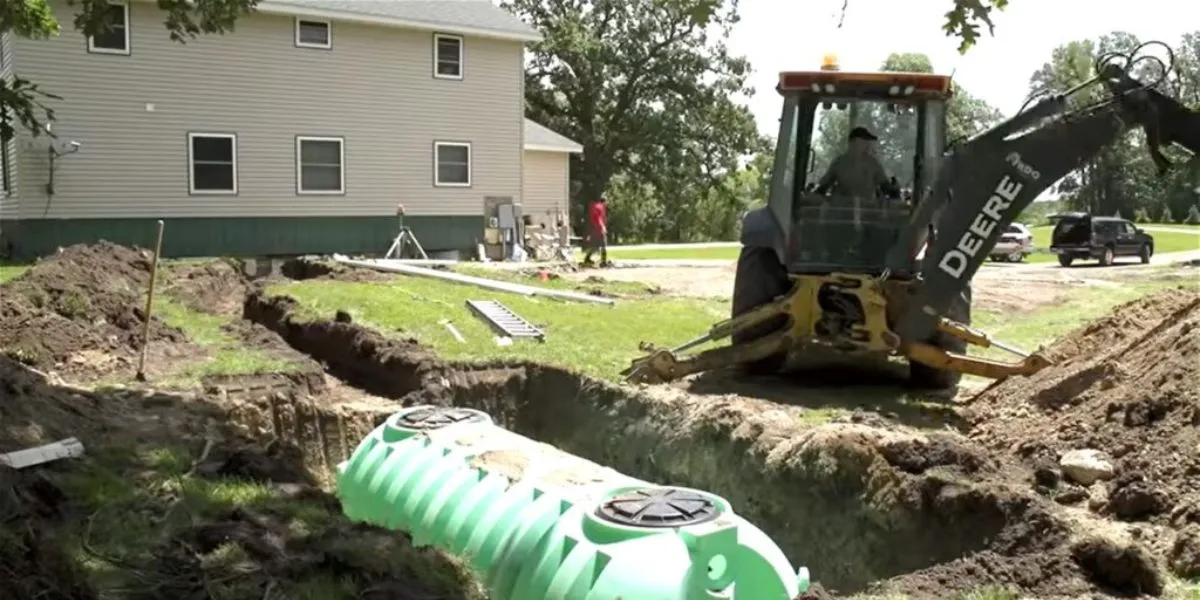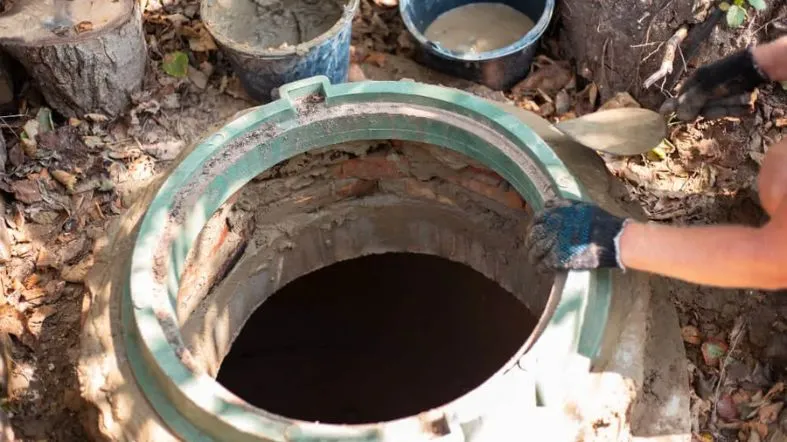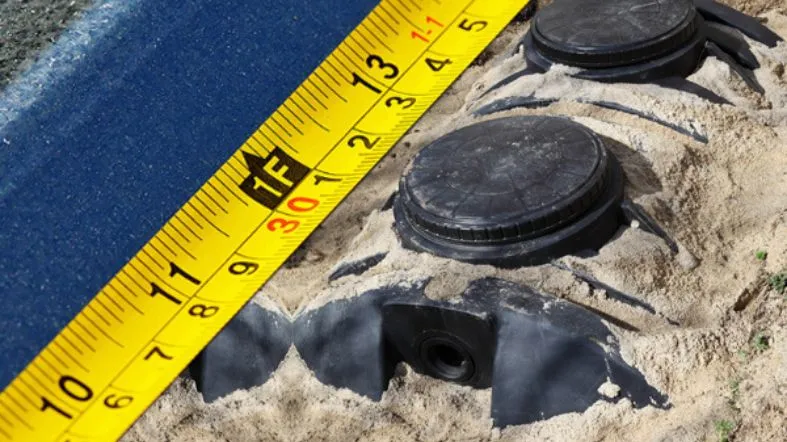Knowing what size septic tank you need is essential for the efficient functioning of your wastewater system.
The right size ensures proper waste treatment, saving you from costly repairs and environmental hazards. On the flip side, an incorrectly sized tank can lead to frequent pump-outs, unpleasant odors, and even legal issues.
In this comprehensive guide, we’ll walk you through the crucial steps in determining the size that’s right for you.
We’ll also delve into the various types of septic tanks available and what you should know about the installation process. So, read on!

What Size Septic Tank Do I Need?
For a 3-bedroom house with moderate water use, a 1,000-gallon tank is generally suitable. For a 4-bedroom house, you’ll need a 1,200-gallon tank. The size of a septic tank you need depends on the number of bedrooms in your home and daily water usage.
Here’s a simple chart for reference:
| No. of Bedrooms | No. of People | Suggested Septic Tank Size (in gallons) |
|---|---|---|
| 1-2 | 1-3 | 750-900 |
| 3-4 | 4-6 | 1,000-1,200 |
| 5+ | 7+ | 1,200-1,500 |
| 3-4 | 4-6 | 1,200-1,400 |
| 5+ | 7+ | 1,500-2,000+ |
Types of Septic Tanks Based on Material
Concrete Tanks
Concrete tanks are a popular choice due to their durability. They’re built to last! But remember, they can crack over time.
This usually happens if the soil around the tank shifts or if the tank is not properly maintained. So, if you choose a concrete tank, make sure to inspect it regularly for any signs of damage.
Plastic Tanks
If you’re looking for something lightweight and easy to install, plastic tanks might be the way to go. They’re made from high-density polyethylene, which is resistant to rust and corrosion.
However, they may not be as sturdy as concrete or steel tanks. So, they might not be the best choice if your property sees heavy traffic or if the tank will be installed in an area with a lot of ground movement.
Fiberglass Tanks
Fiberglass tanks are another great option. They’re resistant to rust and corrosion, just like plastic tanks. Plus, they’re stronger and more rigid than plastic, which makes them a bit more durable.
But keep in mind, that fiberglass tanks can be more expensive than other options. So, you’ll need to consider your budget.
Steel Tanks
Last but not least, we have steel tanks. These tanks are strong and durable, making them a good choice for properties with heavy traffic. But here’s the catch: steel can rust over time if it’s not properly maintained.
If you choose a steel tank, make sure to check it regularly for signs of rust and get it treated right away if you spot any.
Factors Determining Septic Tank Size

Number of Bedrooms or Household Members
The number of people living in your home plays a big role in the size of your septic tank. More people means more wastewater. So, if you have a large family, you’ll need a larger septic tank.
Daily Water Usage
How much water does your household use each day? High water usage can fill up a septic tank quickly. If your household uses a lot of water, consider getting a larger tank.
Soil Absorption Rate
The rate at which your soil absorbs water is also important. If your soil absorbs water slowly, you’ll need a larger septic tank to handle the extra wastewater.
Local Building Codes and Regulations
Don’t forget to check your local building codes! They may have specific requirements for septic tank size. Always make sure your septic system is up to code.
Future Expansion Plans
Planning to add more bedrooms or bathrooms in the future? You should consider getting a larger septic tank now. It’s easier and cheaper to install a larger tank from the start than to upgrade later.
Climate and Geography
Your local climate and geography can also affect septic tank size. In colder climates, septic tanks should be larger to prevent the system from freezing. And if your property is on sloping land, you may need a larger tank.
Tank Shape and Design
Finally, the shape and design of your septic tank can affect its capacity. Some designs are more space-efficient than others. So, consider the shape and design when choosing your septic tank size.
Calculating the Right Septic Tank Size for your need

Determine the Number of Bedrooms in Your Home
First things first, count the number of bedrooms in your house. Even if a room is an office or a guest room, count it as a bedroom.
For example, if you have 3 bedrooms and an office, say you have 4 bedrooms. This number helps us understand how much waste and water will flow into the septic tank.
Check Local Building Codes and Regulations
Don’t skip this step! Every town or city has rules about septic tanks. Make sure to check the local codes.
You might need a specific size, or there may be restrictions. For example, your town might say all new septic tanks must hold at least 1,000 gallons.
Use the Bedroom to Gallon Rule
Many experts use a simple rule: for each bedroom, you need 250 gallons of septic tank space. So, if you have 4 bedrooms, multiply 4 by 250. You’ll need a tank that’s at least 1,000 gallons.
Factor in the Number of People in Your Home
The more people in your house, the bigger the septic tank should be. A family of 6 will use more water than a family of 3. If your family has 6 people, you might add an extra 250-500 gallons to be safe. This makes sure your septic tank doesn’t fill up too quickly.
Add Additional Capacity for Garbage Disposals
Garbage disposals add extra waste to a septic system. If you have one, you’ll need a bigger tank. Add about 50% more capacity. For instance, if you needed a 1,000-gallon tank, now aim for a 1,500-gallon tank.
Take into Account the Laundry Volume
Laundry also uses a lot of water. If you do more than 10 loads a week, think about adding another 250 gallons. So if you had planned for a 1,000-gallon tank, now aim for 1,250 gallons.
Seek Professional Advice
Even after doing all these calculations, it’s good to get expert help. Find a local septic tank installer and ask for their opinion.
They can look at your land, your house size, and other factors you might not know about. For example, some soil types need a bigger tank.
Keep Future Needs in Mind
Planning on growing your family? Think you’ll add more bedrooms later? Plan for this now. It’s cheaper to get a bigger tank now than to replace it later. If you think you’ll have 2 more kids, add an extra 500 gallons to your current need.
Future Planning: Extra Capacity
Sure, here’s the table you requested:
| Future Needs | Additional Gallons |
|---|---|
| Planning 1 More Child | 250 Gallons |
| Adding a Guest Room | 250 Gallons |
| Installing a Second Bathroom | 250 Gallons |
Review and Make the Final Decision
Now, gather all this information. Look at the minimum size from local codes, the size from the bedroom-to-gallon rule, and any extra gallons you added. Pick the biggest number. That’s the safest bet for your new septic tank size.
Septic Tank Sizing Chart for Different Number of Bedrooms
| Number of Bedrooms | Base Gallon Size (Bedroom to Gallon Rule) |
|---|---|
| 1 | 250 Gallons |
| 2 | 500 Gallons |
| 3 | 750 Gallons |
| 4 | 1,000 Gallons |
| 5 | 1,250 Gallons |
| 6 | 1,500 Gallons |
Factors That Increase Septic Tank Size
| Additional Factors | Additional Gallons Needed |
|---|---|
| Extra Family Members | 250-500 Gallons |
| Garbage Disposal | Add 50% to Base Size |
| High Laundry Volume | 250 Gallons |
Example Calculation Table for a 4-Bedroom Home with Extra Factors
| Factor | Gallons |
|---|---|
| Base size for 4 bedrooms | 1,000 Gallons |
| 6 family members | 500 Gallons |
| Garbage Disposal | 500 Gallons |
| High Laundry Volume | 250 Gallons |
| Total Gallons Needed | 2,250 Gallons |
Future Planning: Extra Capacity
| Future Needs | Additional Gallons |
|---|---|
| Planning 1 More Child | 250 Gallons |
| Adding a Guest Room | 250 Gallons |
| Installing a Second Bathroom | 250 Gallons |
Common Mistakes to Avoid When Sizing a Septic Tank

Neglecting Local Codes
One common mistake is neglecting local building codes. These codes are there for a reason, so always check them before installing a new septic system.
For example, your local code might require a minimum septic tank size based on the number of bedrooms in your home.
Ignoring Future Needs
Another mistake is ignoring future needs. If you plan to expand your home in the future, you should plan for this when choosing a septic tank size.
For instance, if you plan to add a new bedroom, you’ll need a larger septic tank to handle the additional wastewater.
Choosing the Cheapest Option
Choosing the cheapest option can also lead to problems down the road. A cheaply made septic tank might not last as long and could lead to costly repairs.
So, don’t sacrifice quality for cost. It’s better to invest in a high-quality septic tank that will last for years.
Failing to Account for Seasonal Changes
Failing to account for seasonal changes is another common mistake. Changes in weather and groundwater levels can affect your septic system’s performance.
For example, in areas with heavy rainfall, a larger septic tank might be needed to handle the extra water.
Forgetting Maintenance Requirements
Finally, don’t forget about maintenance requirements. Regular maintenance is key to keeping your septic system running smoothly.
This includes pumping out the tank regularly to prevent it from getting too full. So, factor this into your decision-making process when choosing a septic tank size.
FAQs
Can I use a smaller septic tank for a large family if we conserve water?
No, conserving water won’t adequately compensate for a too-small septic tank in a large household; it’s better to size according to guidelines.
Is it mandatory to consult local building codes for septic tank sizing?
Yes, it’s essential to consult local building codes as they may have specific requirements or minimums for septic tank sizes.
Are concrete septic tanks more durable than plastic ones?
Yes, concrete septic tanks are generally more durable but require regular inspection for cracks and damage.
Do fiberglass tanks require less maintenance than steel tanks?
Yes, fiberglass tanks generally require less maintenance as they are resistant to rust and corrosion unlike steel tanks.
Are soil absorption rates a factor in septic tank sizing?
Yes, soil absorption rates are important; slower absorption rates may necessitate a larger tank.
Conclusion
Choosing the right size for your septic tank is crucial for efficient waste management.
Always consider factors like household size, water usage, and local regulations. When in doubt, consult with a professional. Remember, a well-planned septic system is an investment in your property’s future.
